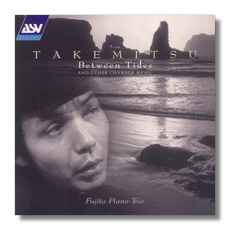
The Internet's Premier Classical Music Source
Related Links
- Takemitsu Reviews
- Latest Reviews
- More Reviews
-
By Composer
-
Collections
DVD & Blu-ray
Books
Concert Reviews
Articles/Interviews
Software
Audio
Search Amazon
Recommended Links
Site News
 CD Review
CD Review
Tōru Takemitsu

Between Tides
- Between Tides
- Romance
- Distance de fée
- Piano Pieces for Children
- Rain Tree Sketch
- From Far Chrysanthemums And November Fog
- Orion
- Litany – In Memory of Michael Vyner
- Rain Tree Sketch II – In Memoriam Olivier Messiaen
Fujita Piano Trio
Academy Sound & Vision CDDCA1120 DDD 71:42
The works on this CD span almost a half-century. Romance, a four-minute piano piece heavily redolent of Debussy, was completed before Tōru Takemitsu was out of his teens. Distance de fée, which came shortly after, reflects the young composer's great respect for Olivier Messiaen. Scored for violin and piano, it already shows fingerprints of the composer's mature style as well.
On the other hand, Between Tides was completed in 1993, just three years before Takemitsu's death. This is the only work on this CD that all three members of the Fujita Trio – pianist Megumi Fujita, violinist Arisa Fujita, and cellist Honoka Fujita – are needed for. (The original dedicatees and performers were Pamela Frank, Yo-Yo Ma, and Peter Serkin.) Between Tides is Takemitsu at his most characteristic. The French influence is easily recognized, but Takemitsu's sensuality has a finer grain to it, and his concern for the meaning and impact of every sound is almost obsessive. So many of his works are about water. Between Tides, true to its title, ebbs and flows unstoppably through the course of its 15-minute length. Takemitsu prevents the music from drifting into merely impressionistic prettiness by grounding it with recurring motifs, textures, and patterns. Debussy's La mer depicts the sea in all its moods. Takemitsu's piece does the same, but with infinitely more intimacy.
The works that come in between don't always reach as far as Between Tides, but all of them are worthwhile, and some are more overtly emotional. The child who plays the two Piano Pieces for Children ("Breeze" and "Clouds") will not feel condescended to at all by Takemitsu's charm and fancy. The Litany – In Memory of Michael Vyner is based on material written in 1950 when the composer was bedridden with nearly fatal tuberculosis. It is moving to hear the older Takemitsu looking back at the sickbed of the younger one to find inspiration for his tribute to Vyner, whose efforts on behalf of new music in general and Takemitsu in particular meant so much to the composer.
The performances on this CD work well. Pianist Megumi Fujita plays Takemitsu's works with an excellent feeling for their subtle colors and stillness. Her sisters Arisa and Honoka are similarly skilled, although I did find Arisa's intonation to be not always the most pleasing; there is some stridency, and I am not sure whether it is due to her playing, her instrument, or to the engineering. On the whole, though, the pleasures given by this CD far outweigh this concern. My other reservation is really more of an observation: most of this music, exquisite as it is, is quiet and slow. I don't recommend playing all of this CD at one sitting, or you might lose the nuances that distinguish these works from one another.
Copyright © 2001, Raymond Tuttle


















